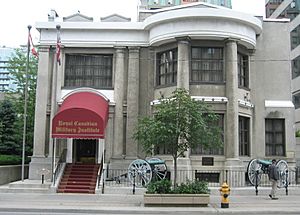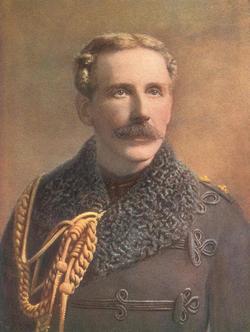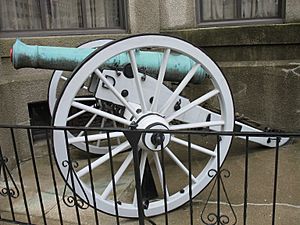Royal Canadian Military Institute facts for kids

The RCMI clubhouse in 2008,
before the site was redeveloped |
|
| Abbreviation | RCMI |
|---|---|
| Founded | 1890 (as the Canadian Military Institute) |
| Type | Private members' club |
| Purpose | Research, discussion and education in defence studies |
| Location | |
|
Region served
|
Canada |
|
Official language
|
English, French |
The Royal Canadian Military Institute (RCMI) is a special club in Toronto, Ontario, Canada. It's a place where people interested in military history, how countries protect themselves (called defence studies), and what's happening around the world (like international affairs) can meet. It started on January 14, 1890, as the Canadian Military Institute.
General Sir William Dillon Otter helped create the RCMI. He wanted it to be a library, museum, and club for Canada's defence forces. The goal was to learn about military art, science, and literature. It also aimed to collect and keep important records of Canada's defence history. The RCMI's motto is Fidelis Per Manere, which is Latin for 'To remain faithful'.
The RCMI's first main building at 426 University Avenue was built in 1907. An architect named William Craven Vaux Chadwick designed the library part in 1908. The building grew in 1912 and 1935, and it was updated in the 1960s. In 2007, the front of the building was rebuilt to look like its original design. In 2012, Governor General David Johnston helped lay the cornerstone for a new, much taller building. This new building includes a 42-story condominium tower.
The RCMI has a special leader called the colonel in chief, who is Princess Alexandra, The Honourable Lady Ogilvy. The club gets its support from membership fees, donations, and volunteers.
Contents
What the RCMI Does
The RCMI is a place for people to learn and talk about defence, safety, and international topics. They want to be known as the best place in Canada for these discussions. The RCMI also works to encourage the study of military plans, arts, and literature. They hope to make Canadians proud of their country by helping them understand its political and military past.
Events and Programs
The RCMI hosts many events for the public. These include talks by guest speakers, educational conferences, and open discussions. They also have special dinners and parties, like Christmas parties. Regular talks are held on Canadian military history, world events, and military strategies. These are often part of their Military History Nights and Defence Studies Committee meetings.
The RCMI also writes and publishes its own papers, studies, and journals. These are about military and strategic issues, foreign affairs, and historical items. Some of their publications include 'RCMI Commentary' and 'Sitrep'. They have also published annual yearbooks.
Collections and Facilities
The RCMI has a museum, an archive (for old records), a library, and an art collection. They also have online resources. The museum shows how Canadian military weapons, equipment, and uniforms have changed over time.
After being rebuilt for four years, the RCMI moved back into its new home at 426 University Avenue in June 2014. The RCMI also offers places for members to stay overnight and has food and drink services.
A Look Back: RCMI's History
Starting as the Canadian Military Institute
On January 14, 1890, 50 army officers in Toronto started the club. It was first called the Canadian Military Institute (CMI). The governor general of Canada at the time, Lord Stanley, was its patron. Another group, the Militia Institute, gave the new club 200 military books. The founders hoped to have 50 to 100 members by the end of 1890. But they ended up with 162 local members and 122 members from other areas. The CMI's main building in 1896 was on University Avenue.
In 1907, the CMI bought land behind its current location. On August 29, 1907, Governor General Earl Grey laid a special cornerstone. William Craven Vaux Chadwick designed the new CMI Library on University Avenue in 1908. In 1912, the CMI bought the front part of its current property. The Duke of Connaught, who was governor general then, laid another cornerstone.
Colonel J. B. McLean was the last of the RCMI's founders to pass away. He was an honorary president from 1948 until his death in 1951.
The first president of the institute was Lieutenant Colonel William Dillon Otter. He became a very important military figure in Canada. Colonel Otter set the club's first goals: to encourage military art, science, and literature in Canada.

At first, from 1890 to 1940, only male army officers and former officers could join. In 1940, this was changed to include male officers and former officers from the army, navy, and air force.
Around 1914, the institute was losing money. But when World War I started, many new members joined. After the war, from 1919 to 1930, the club was doing well financially. However, after 1930, membership slowly went down. During the Great Depression, many members could not afford the yearly fee. The club faced tough times, but new financial plans helped it survive. From 1936 until 1958, the institute made a profit.
In 1943, a woman officer from the Canadian Women's Army Corps tried to join. Even though the rules didn't say members had to be male, she was not allowed to join. However, some changes were made for women. Wives of members could attend "Open Nights" once a month. Members could also bring female guests to the Ladies Lounge for dinner and drinks.
Becoming the Royal Canadian Military Institute
In 1946, the first naval officer to be president, Commander A. C. Turner, wanted to change the name to "The Canadian Officers' Club and Institute."
In 1948, the club had its first Air Force officer as president. That same year, the Honourable Colin Gibson helped the institute ask King George VI for permission to use the word "Royal" in its name. The King agreed in 1948, but only if the name went back to Canadian Military Institute first. So, it became the Royal Canadian Military Institute.
In 1948, the RCMI had a record number of members, 2389. But by 1958, the number had dropped to 1925. Many members lived in Toronto, but there was also a special fee for members who lived elsewhere in Canada but visited Toronto.
In late 2008, the RCMI decided to tear down its old building. They made a deal to build a 42-story condominium tower. In return, the RCMI would get a larger space in the new building. The old building's historic front and much of its inside were rebuilt in the RCMI's new space. This helped the institute avoid the high costs of keeping up a very old building.
The RCMI closed its old building with a flag-lowering ceremony on June 18, 2010. The building was taken down in 2010. After four years of rebuilding, the RCMI moved into its new home at 426 University Avenue in June 2014. While the new building was being built, from 2010 to 2014, members met at the Albany Club. Popular RCMI events, like Military History Nights, continued during this time. The library and museum items were kept safe, and work on the collections went on.
RCMI Museum
The RCMI Museum works to protect and care for its collections. The museum has old and new weapons, like guns, swords, and spears from all over the world. It also has other military items, many given by members. These include flags, badges, uniforms, and medals. Captain Roy Brown, who was famous for shooting down Baron Manfred von Richthofen, the "Red Baron," in 1918, gave the museum the seat from the Red Baron's plane.
The art collection focuses on Canadian and British Military History. It includes small paintings, photos, sketches, watercolors, and oil paintings. The RCMI also has a collection of British, American, and French soldier figurines.
RCMI Library
The Militia Institute gave 200 military books to the RCMI when it started. The library has military manuals, journals, and rare books that date back to the 1700s. William Craven Vaux Chadwick designed the new CMI Library on University Avenue in 1908. By 1958, the RCMI had over 12,000 military books.
The library has many Canadian regimental histories and books about ships and squadrons. It also has books from the time of Napoleon and army lists going back to 1746. There are also lists of British and Canadian officers for the army, navy, and air force. The library has one of only four collections of 134 volumes of letters from the United States Civil War. Two other copies are in the Congress Library in Washington and the Smithsonian Institution in Baltimore. Colonel George A Drew, who wrote "Canada's Fighting Airmen" in the RCMI Library, called it "a unique treasury of British and Canadian military literature and journalism." The library also has a collection of Canadian Official War Photographs from World War One. There are also lists of soldiers and battle plans for World War I and World War II.
Images for kids







